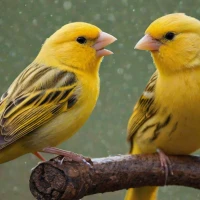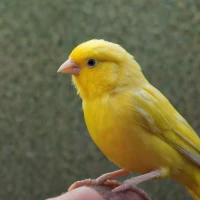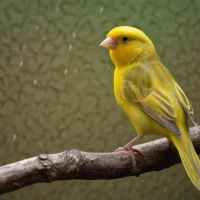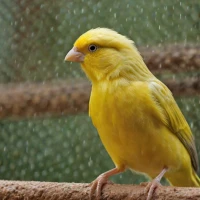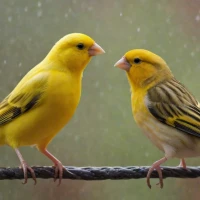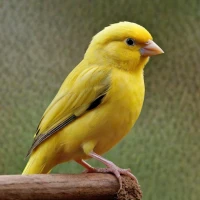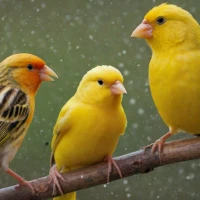A Journey Through the Rainbow: The Colorful World of Canaries
Once upon a time, in the early days of my veterinary practice, I was met with an elderly couple who brought in a chirpy little canary named Sunny. The golden hue of Sunny’s feathers caught my attention immediately. It wasn’t the first time I’d seen a yellow canary, but for some reason, this one stood out. And that’s when it hit me - these beautiful birds come in a plethora of vivid colors that many people aren’t even aware of! 🌈 That encounter sparked my fascination and led me to explore the kaleidoscopic world of canary colors.
The Classic Yellow Canary
Most people, when they think of canaries, picture the bright yellow variant. Sunny certainly fit that mold. 🐥 The classic yellow canary has been selectively bred for its striking yellow feathers that almost seem to capture sunlight. These birds are like little sunshine ambassadors in any home. Believe it or not, the color can range from a pale lemon to deep saffron. And you know what? The depth of color can depend on their diet, especially if rich in beta-carotene. Wild, right?
Orange and Red Factor Canaries
Next up are the red factor canaries, which are quite the show-stoppers. The story goes that these canaries were developed in the 1920s by breeding the Yellow Canary (Serinus canaria) with the Red Siskin (Spinus cucullatus). The result? Birds with shades ranging from vibrant red to soft orange. Amazing, huh?
Red factor canaries require a special diet to maintain their rich colors. If they’re not fed foods high in carotenoids, like red peppers, their feathers can dull. It’s kinda like how eating carrots supposedly helps our eyesight - same principle but for feathers!
White Canaries: Pure Elegance
What if you prefer something more understated? White canaries bring pure elegance to the table. There are two main types: Recessive White and Dominant White. The recessive white canaries are completely white with no underlying yellow pigment, while the dominant white ones have a slight yellowish tinge on the flight feathers. These birds look so pristine, almost like little fluffy snowballs! 🌨️ Their silent majesty can often make one feel like they’re staring into a fresh winter morning - crisp, clean and serene.
Blue and Silver Canaries: Mystical Beauties
Ever seen a blue canary? No, it’s not an aviary urban myth! While blue canaries aren’t actually blue the way one might think, they have a blue-gray hue that looks enchanting. Likewise, silver canaries flaunt a metallic sheen that makes them appear almost mystical. Have you ever watched a bird and felt like you’re catching a glimpse of nature’s magic? Yeah, exactly that! ✨
Green or Cinnamon Canaries
For those who love the rustic charm, green or cinnamon canaries are the way to go. Green canaries have a mix of yellow and black, giving them an olive hue. They remind me of the wild canaries of the Canary Islands (fun fact: that’s where their name comes from, not from the color - mind blown, right?). Cinnamon canaries, on the other hand, blend brown and yellow, producing warm, earthy tones that add a grounded elegance to any aviary.
Brown or Fawn Canaries
Brown or fawn canaries offer neutral yet beautiful tones. These colors arise from mutations affecting melanin pigments in their feathers. Browns can range from dark chocolate hues to light tan, while fawns are usually softer, like a mild coffee with plenty of cream. Ever enjoyed a cup of latte while watching the birds outside? These canaries could very well be the bird version of that cozy comfort.
Mosaics and Variegated Canaries: Nature’s Artistry
How about we talk a bit about mosaics and variegated canaries? These birds look like walking pieces of art. Mosaics have a distinct pattern with spots of intense color on their feathers. Typically, you’ll see reds or yellows popping up against their white backgrounds - quite the spectacle!
Variegated canaries, on the other hand, have patches or spots in different colors, usually a mix of dark and light. They remind me of those lovely patchwork quilts Granny used to make. Each bird is like a unique masterpiece crafted by Mother Nature herself. 🖼️
Unique Feathery Friends
Ever heard of the Crested Canary? With a funny feather “crown” or topknot, these birds have an eccentric flair. They can come in all sorts of colors, and their crest only adds to their charming personality.
Another unique variant is the Frilled Canary. Their feathers curl and frill outwards, giving them a sort of puffy, extravagant look. Imagine the bird fashion week - these would definitely be the runway stars!
Pigment and Diet: Feeding for Feather Fame
Did you know, what you feed your canary greatly influences its color? Yep, that’s right. For example, for red factor canaries, incorporating foods like red peppers, carrots or specialized color food can enhance their red coloration. Diet is crucial and fascinating. You are what you eat, and canaries sometimes turn the phrase into literal truth!
Challenges of Breeding Colorful Canaries
Breeding canaries to achieve specific colors is no walk in the park. Genetics can be as unpredictable as the weather. Remember my friend Jake? He spent years trying to perfect a line of bronze canaries. Consistent results can be challenging to achieve and sometimes downright frustrating. It’s Moreso an art backed by science and a whole lot of patience.
Hues and Habitat: The Color Connection
The habitat can also have an impact on the color of canaries. Clean, well-ventilated environments with natural sunlight can actually enhance feather coloration. So if you’re dreaming of raising vividly colored birds, remember to give them a habitat that supports their health and vibrant hues.
Canary Care: A Symphony in Colors
Here’s a little interesting tidbit: stress can cause canaries to molt prematurely, leading to temporary loss of pigment. Keeping a calm, serene environment can also help these birds retain their dazzling colors. Stress is a silent thief - who knew it could even steal colors?
Finally, in closing, the world of canary colors is vast and truly spectacular. From sunny yellows to enigmatic blues, these birds fill our lives with hues we often take for granted. They remind us that variety is the spice of life, and sometimes, the most unexpected places can hold the most beauty.
Thanks for fluttering through this colorful journey with me! Here’s hoping your life is as bright and beautiful as a rainbow! 🌈🐥
-Cheers, The Veterinary Expert 💛
P.S. Fun Random Fact: Did you know canaries were used in coal mines as early warning systems? If toxic gases like carbon monoxide were present, the sensitive birds would show signs of distress before the miners, giving them time to escape. Now that’s one colorful hero!



